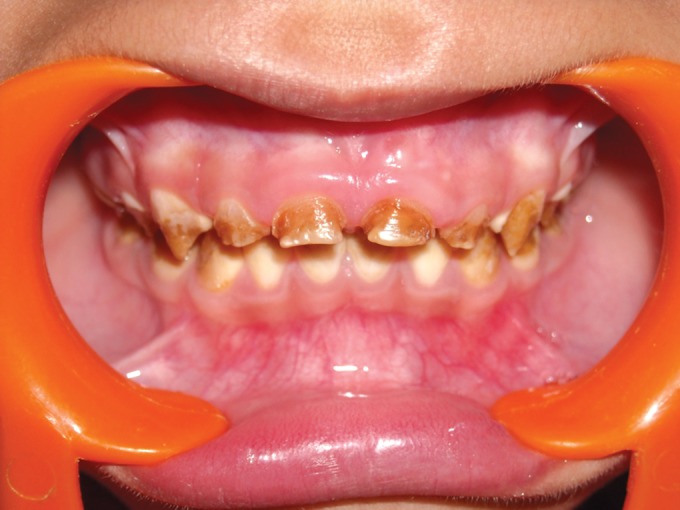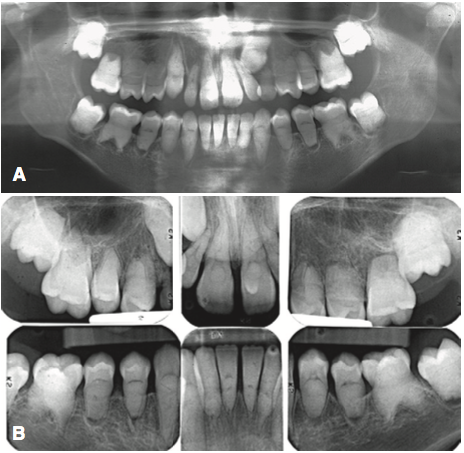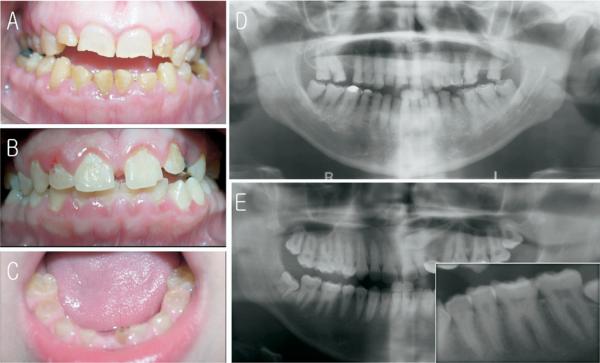Dentin anomalies
Anomalies of the dentin can either be hereditary or caused by environmental factors. The hereditary conditions are of the autosomal dominant type and affect both dentitions (temporary and permanent). The disorder is often caused by mutations in the genes that code for collagen and phosphoproteins, these genes are COL1A1, COL1A2 and DSPP. Following is a brief description of dentin conditions:
Dentinogenesis Imperfecta
Dentinogenesis imperfecta is caused by a mutation in the DSPP gene. Clinically, the color of the teeth range from yellow to blue/grey. They are translucent and the crowns are bulb-shaped. The roots are short and the pulp chambers can be completely obliterated over time. The enamel is normal. Deciduous teeth are more affected than permanent teeth.


Dentin Dysplasia
There are two types of dentin dysplasia. Type 1 is more frequent than type 2 and is also called rootless teeth since the roots are very short which leads to premature tooth loss. The enamel and the dentin in the crown are normal, only the dentin in the root is abnormal. There are multiple peri-apical lesions. Deciduous dentition is affected more severely than permanent dentition.


Type 2 appears clinically similar to dentinogenesis imperfecta. In deciduous dentition, the crown is amber and bulb-shaped and the pulp chamber disappears post-eruption. However, unlike dentinogenesis imperfecta, the roots are not affected. In permanent dentition, the teeth appear clinically normal but there are anomalies of the pulp chamber, it is flame shaped with pulp stones. There are no peri-apical lesions.


Osteogenesis Imperfecta
Osteogenesis imperfecta is one of the most common genetic bone disorders. It is caused by a mutation in the genes (COL1A1 and COL1A2) that code for type 1 collagen, an important constituant of bones, dentin, ligaments etc. The most common signs of this condition are fragile bones, hearing loss, looseness in the joints and a blue sclera. Patients with osteogenesis imperfecta can also have dental symptoms similar to dentinogenesis imperfecta. Patients also have maxillary hypoplasia which is responsible for a class 3 malocclusion (underbite).


- White S, Pharoah M. (2014). Oral Radiology Principles and Interpretation. Missouri: Elsevier Inc.
- Lee SK, Hu JC, Lee KE, Simmer JP, Kim JW. A dentin sialophosphoprotein mutation that partially disrupts a splice acceptor site causes type II dentin dysplasia. J Endod. 2008 Dec;34(12):1470-3.
- Malik S, Gupta S, Wadhwan V, Suhasini GP. Dentin dysplasia type I - A rare entity. J Oral Maxillofac Pathol. 2015 Jan-Apr;19(1):110.
- Costa FW, Chaves FN, Nogueira AS, Rodrigues Carvalho FS, Pereira KM, Kurita LM, Rodrigues RR, Fonteles CS. Clinical aspects, imaging features, and considerations on bisphosphonate-related osteonecrosis risk in a pediatric patient with osteogenesis imperfecta. Case Rep Dent. 2014;2014:384292.
- Jindal M, Maheshwari S, Verma R, Khan MT. Comparative study of dentinogenesis imperfecta in different families of the same topographical region. Int J Clin Pediatr Dent. 2009 Sep;2(3):27-34.
- Adel Kauzman, Faculté de médecine dentaire, Université de Montréal
